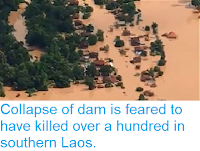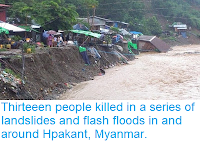On 23 July 2018 the Xe-Pian Xe-Namnoy Project, a recently-opened hydro-electric dam on the Bolaven Plateau in southern Laos collapsed suddenly, releasing approximately half a million cubic metres of water onto villages bellow. Forty people have been confirmed dead following this incident, with another 65 still missing and over 6600 made homeless. Within hours of the failure disagreements had emerged between the Korean contractors who built the dam and the Thai investors who provided the financial backing for the project, with one side claiming that the project had failed due to poor construction, and the other that excessive and unexpected levels of rainfall were to blame, and despite a plea from the Lao Prime Minister for a collaborative approach to investigating the cause of the failure, including globally recognised experts in the field, both parties have appointed their own teams to investigate the failure of the dam, and requests from outside parties for information on the design and construction of the dam have been blocked by lawyers representing these teams.
In a report published by the Blume Earthquake Engineering Center at Stanford University on 26 October 2018, Richard Meehan of the School of Earth Sciences and Blume Earthquake Engineering Center at Stanford University presents a theoretical cause of the dam’s failure, based upon satellite ground elevation data and previous geological surveys of the region carried out by the Japan International Cooperation Agency.
Meehan asserts that the western arm of the dam was built over a dry basin, in which a sinkhole system made up of caves, lava tubes and cracks in the basaltic rock had been infilled by soil, and were quite incapable of supporting the weight of the water behind the dam. He believes that when the dam was filled, water penetrated these systems soaking through or washing away the soil within the sinkhole system, and in some cases causing the surrounding rock to fissure abruptly as the pressure within built up rapidly.
This theory is supported by cloud-piercing satellite images from the Sentinel 1 Satellite, which show a series of rising springs developing as underground conduits fill with water, followed by the superstructure of the dam beginning to sink into the void beneath, before being overtopped by the waters behind and failing completely.
See also...
Meehan asserts that the western arm of the dam was built over a dry basin, in which a sinkhole system made up of caves, lava tubes and cracks in the basaltic rock had been infilled by soil, and were quite incapable of supporting the weight of the water behind the dam. He believes that when the dam was filled, water penetrated these systems soaking through or washing away the soil within the sinkhole system, and in some cases causing the surrounding rock to fissure abruptly as the pressure within built up rapidly.
Progressive failure scenario: (a) 20 July 2018, when 11 cm of subsidence was noted. (b) 22 July, when a warning of engineering failure was issued. (2) 25 July, post failure with fissured basalt rock exposed. Meehan (2018).
This theory is supported by cloud-piercing satellite images from the Sentinel 1 Satellite, which show a series of rising springs developing as underground conduits fill with water, followed by the superstructure of the dam beginning to sink into the void beneath, before being overtopped by the waters behind and failing completely.
See also...
Follow Sciency Thoughts on Facebook.







